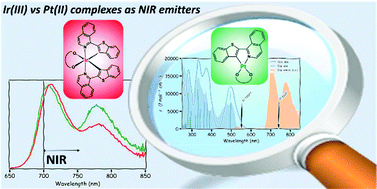Upper limit to the ultimate achievable emission wavelength in near-IR emitting cyclometalated iridium complexes†
Abstract
Iridium complexes bearing cyclometalated (C^N) ligands are the current emitters of choice for efficient phosphorescent organic light emitting diodes (OLEDs). Homoleptic iridium complexes Ir(C^N)3 and the analogous heteroleptic ones carrying a β-diketonate ancillary ligand (C^N)2Ir(O^O) often exhibit similar photophysical properties and device performances; the choice among them usually depends both on the yield/ease of the respective synthetic preparations as well as on the device fabrication methods (i.e. vacuum-deposition or solution-process). In our recent study we found a significant spectral red shift on going from the homoleptic to the β-diketonate Ir(III) derivatives. The NIR emitting complex Ir(iqbt)2dpm (λmax = 710 nm) has almost 20 nm red shifted emission compared to the homologue Ir(iqbt)3 making only the former a real NIR emitter. For comparison, we studied the Pt(iqbt)dpm complex as the suitable example to investigate metal ligand interactions. Noteworthily the Pt(iqbt)dpm emission perfectly overlaps that of the Ir(iqbt)2dpm. In this paper we provide an in-depth investigation of these systems by electrochemical and spectroscopic analyses and corroborate the results with DFT and TDDFT calculations to investigate whether the Pt(II) complex can be used as a model system to predict how far the emission can be pushed in a Ir(III) heteroleptic derivative bearing the same C^N ligand.



 Please wait while we load your content...
Please wait while we load your content...